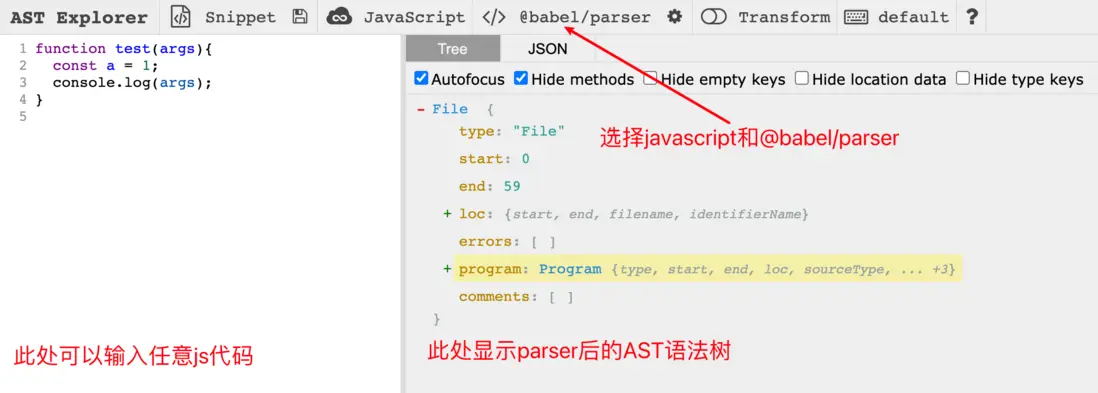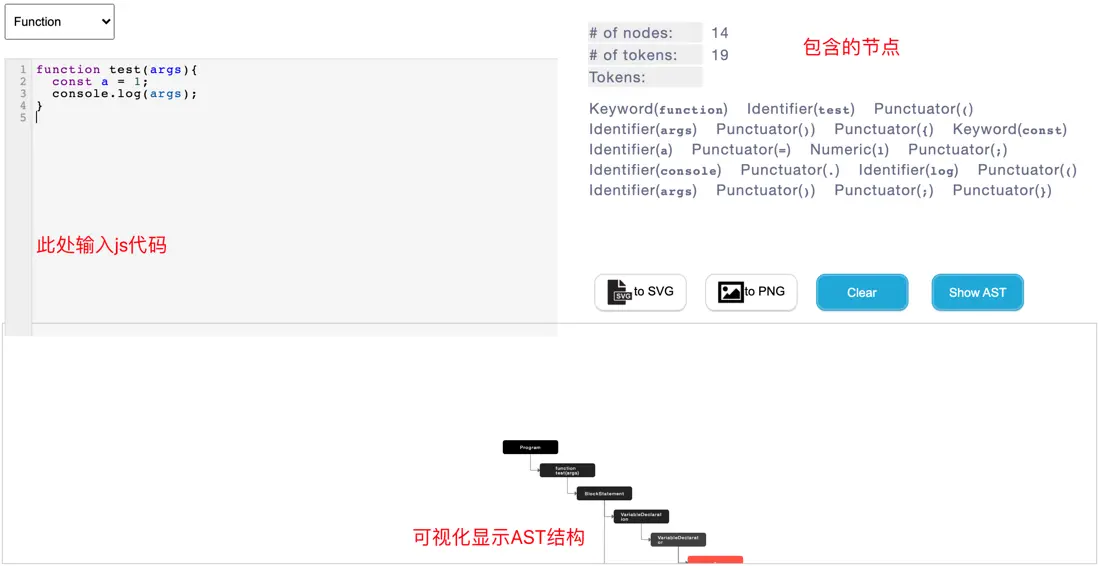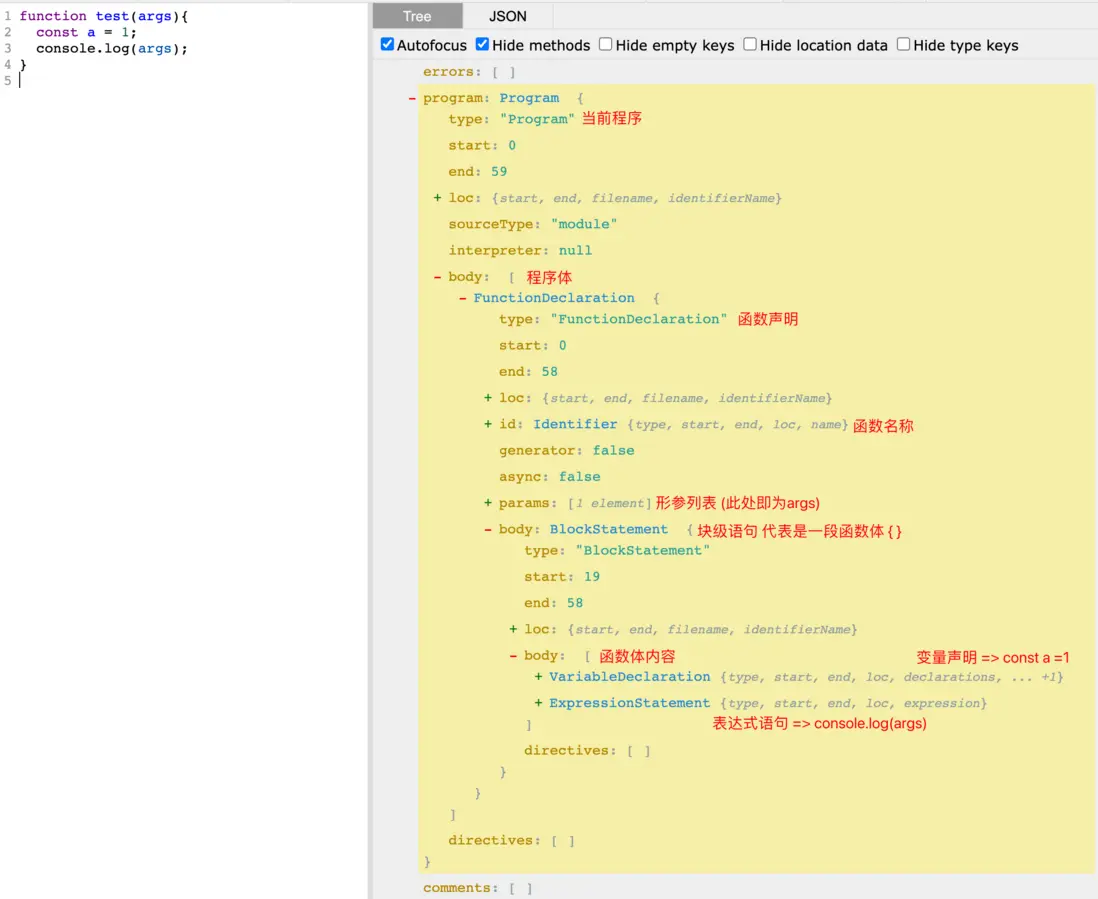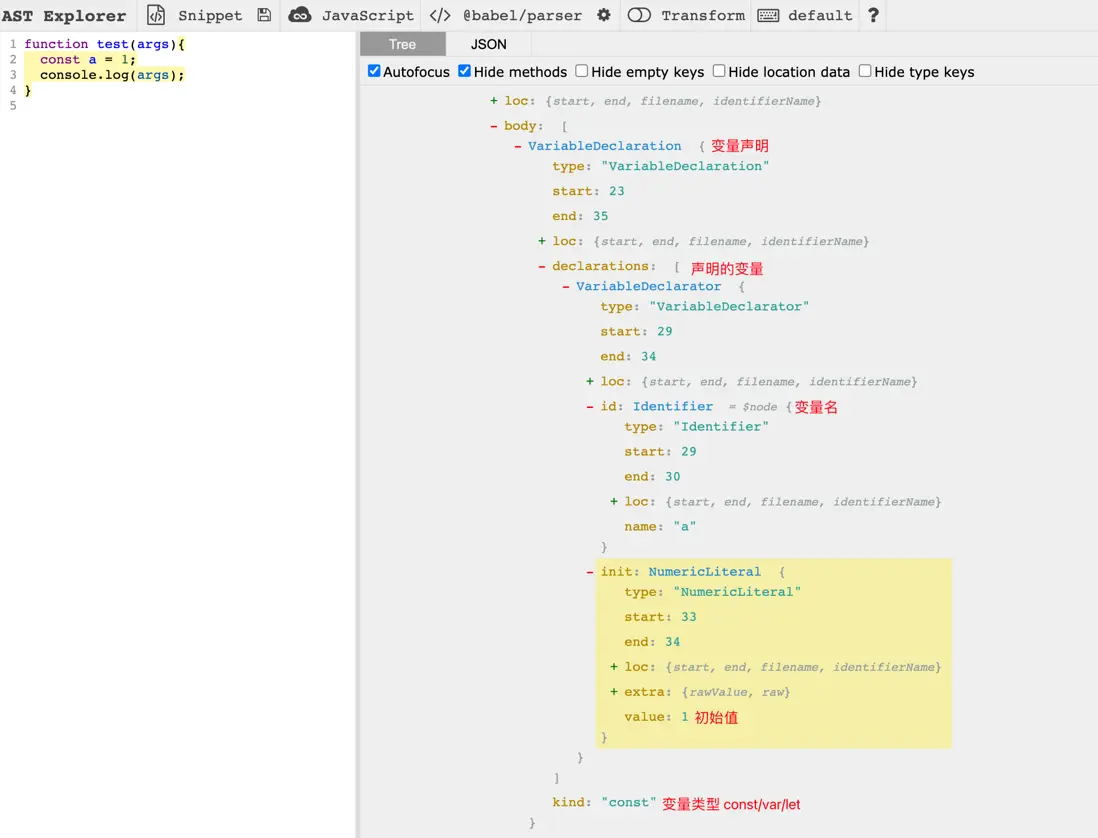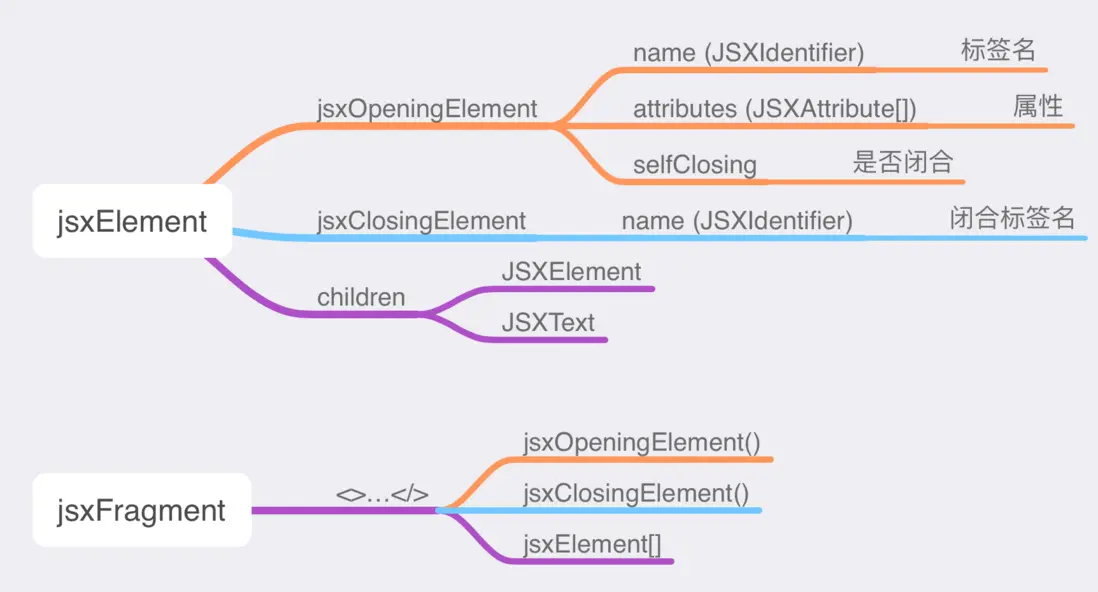作者:BoBoooooo
前言
談及 Babel,必然離不開 AST。有關 AST 這個知識點其實是很重要的,但由於涉及到代碼編譯階段,大多情況都是由各個框架內置相關處理,所以作為開發(使用)者本身,往往會忽視這個過程。希望通過這篇文章,帶各位同學走進 AST,藉助 AST 發揮更多的想象力。
AST 概述
想必大家總是聽到 AST 這個概念,那麼到底什麼是 AST?
AST 全稱是是 Abstract Syntax Tree,中文為抽象語法樹,將我們所寫的代碼轉換為機器能識別的一種樹形結構。其本身是由一堆節點(Node)組成,每個節點都表示源代碼中的一種結構。不同結構用類型(Type)來區分,常見的類型有:Identifier(標識符),Expression(表達式),VariableDeclaration(變量定義),FunctionDeclaration(函數定義)等。
AST 結構
隨着 JavaScript 的發展,為了統一ECMAScript標準的語法表達。社區中衍生出了ESTree Spec,是目前社區所遵循的一種語法表達標準。
ESTree 提供了例如Identifier、Literal等常見的節點類型。
節點類型
| 類型 | 説明 |
|---|---|
| File | 文件 (頂層節點包含 Program) |
| Program | 整個程序節點 (包含 body 屬性代表程序體) |
| Directive | 指令 (例如 "use strict") |
| Comment | 代碼註釋 |
| Statement | 語句 (可獨立執行的語句) |
| Literal | 字面量 (基本數據類型、複雜數據類型等值類型) |
| Identifier | 標識符 (變量名、屬性名、函數名、參數名等) |
| Declaration | 聲明 (變量聲明、函數聲明、Import、Export 聲明等) |
| Specifier | 關鍵字 (ImportSpecifier、ImportDefaultSpecifier、ImportNamespaceSpecifier、ExportSpecifier) |
| Expression | 表達式 |
公共屬性
| 類型 | 説明 |
|---|---|
| type | AST 節點的類型 |
| start | 記錄該節點代碼字符串起始下標 |
| end | 記錄該節點代碼字符串結束下標 |
| loc | 內含 line、column 屬性,分別記錄開始結束的行列號 |
| leadingComments | 開始的註釋 |
| innerComments | 中間的註釋 |
| trailingComments | 結尾的註釋 |
| extra | 額外信息 |
AST 示例
有的同學可能會問了,這麼多類型都需要記住麼? 其實並不是,我們可以藉助以下兩個工具來查詢 AST 結構。
- AST Explorer (常用)
- AST 可視化
結合一個示例,帶大家快速瞭解一下 AST 結構。
function test(args) {
const a = 1;
console.log(args);
}上述代碼,聲明瞭一個函數,名為test,有一個形參args。
函數體中:
- 聲明瞭一個
const類型變量a,值為1 - 執行了一個 console.log 語句
將上述代碼粘貼至AST Explorer,結果如圖所示:
接下來我們繼續分析內部結構,以const a = 1為例:
變量聲明在 AST 中對應的就是 type 為VariableDeclaration的節點。該節點包含kind和declarations兩個必須屬性,分別代表聲明的變量類型和變量內容。
細心的同學可能發現了declarations是一個數組。這是為什麼呢?因為變量聲明本身支持const a=1,b=2的寫法,需要支持多個VariableDeclarator,故此處為數組。
而 type 為VariableDeclarator的節點代表的就是a=1這種聲明語句,其中包含id和init屬性。
id即為Identifier,其中的name值對應的就是變量名稱。
init即為初始值,包含type,value屬性。分別表示初始值類型和初始值。此處 type 為NumberLiteral,表明初始值類型為number類型。
Babel 概述
Babel 是一個 JavaScript 編譯器,在實際開發過程中通常藉助Babel來完成相關 AST 的操作。
Babel 工作流程
Babel AST
Babel 解析代碼後生成的 AST 是以ESTree作為基礎,並略作修改。
官方原文如下:
The Babel parser generates AST according to Babel AST format. It is based on ESTree spec with the following deviations:
- Literal token is replaced with StringLiteral, NumericLiteral, BigIntLiteral, BooleanLiteral, NullLiteral, RegExpLiteral
- Property token is replaced with ObjectProperty and ObjectMethod
- MethodDefinition is replaced with ClassMethod
- Program and BlockStatement contain additional directives field with Directive and DirectiveLiteral
- ClassMethod, ObjectProperty, and ObjectMethod value property's properties in FunctionExpression is coerced/brought into the main method node.
- ChainExpression is replaced with OptionalMemberExpression and OptionalCallExpression
- ImportExpression is replaced with a CallExpression whose callee is an Import node.
Babel 核心包
| 工具包 | 説明 |
|---|---|
@babel/core |
Babel 轉碼的核心包,包括了整個 babel 工作流(已集成@babel/types) |
@babel/parser |
解析器,將代碼解析為 AST |
@babel/traverse |
遍歷/修改 AST 的工具 |
@babel/generator |
生成器,將 AST 還原成代碼 |
@babel/types |
包含手動構建 AST 和檢查 AST 節點類型的方法 |
@babel/template |
可將字符串代碼片段轉換為 AST 節點 |
npm i @babel/parser @babel/traverse @babel/types @babel/generator @babel/template -DBabel 插件
Babel 插件大致分為兩種:語法插件和轉換插件。語法插件作用於 @babel/parser,負責將代碼解析為抽象語法樹(AST)(官方的語法插件以 babel-plugin-syntax 開頭);轉換插件作用於 @babel/core,負責轉換 AST 的形態。絕大多數情況下我們都是在編寫轉換插件。
Babel 工作依賴插件。插件相當於是指令,來告知 Babel 需要做什麼事情。如果沒有插件,Babel 將原封不動的輸出代碼。
Babel 插件本質上就是編寫各種 visitor 去訪問 AST 上的節點,並進行 traverse。當遇到對應類型的節點,visitor 就會做出相應的處理,從而將原本的代碼 transform 成最終的代碼。
export default function (babel) {
// 即@babel/types,用於生成AST節點
const { types: t } = babel;
return {
name: "ast-transform", // not required
visitor: {
Identifier(path) {
path.node.name = path.node.name.split("").reverse().join("");
},
},
};
}這是一段AST Explorer上的 transform 模板代碼。上述代碼的作用即為將輸入代碼的所有標識符(Identifier)類型的節點名稱顛倒。
其實編寫一個 Babel 插件很簡單。我們要做的事情就是回傳一個 visitor 對象,定義以Node Type為名稱的函數。該函數接收path,state兩個參數。
其中path(路徑)提供了訪問/操作AST 節點的方法。path 本身表示兩個節點之間連接的對象。例如path.node可以訪問當前節點,path.parent可以訪問父節點等。path.remove()可以移除當前節點。具體 API 見下圖。其他可見
handlebook。
Babel Types
Babel Types 模塊是一個用於 AST 節點的 Lodash 式工具庫,它包含了構造、驗證以及變換 AST 節點的方法。
類型判斷
Babel Types 提供了節點類型判斷的方法,每一種類型的節點都有相應的判斷方法。更多見babel-types API。
import * as types from "@babel/types";
// 是否為標識符類型節點
if (types.isIdentifier(node)) {
// ...
}
// 是否為數字字面量節點
if (types.isNumberLiteral(node)) {
// ...
}
// 是否為表達式語句節點
if (types.isExpressionStatement(node)) {
// ...
}創建節點
Babel Types 同樣提供了各種類型節點的創建方法,詳見下屬示例。
注: Babel Types 生成的 AST 節點需使用@babel/generator轉換後得到相應代碼。
import * as types from "@babel/types";
import generator from "@babel/generator";
const log = (node: types.Node) => {
console.log(generator(node).code);
};
log(types.stringLiteral("Hello World")); // output: Hello World基本數據類型
types.stringLiteral("Hello World"); // string
types.numericLiteral(100); // number
types.booleanLiteral(true); // boolean
types.nullLiteral(); // null
types.identifier(); // undefined
types.regExpLiteral("\\.js?$", "g"); // 正則"Hello World"
100
true
null
undefined
/\.js?$/g複雜數據類型
- 數組
types.arrayExpression([
types.stringLiteral("Hello World"),
types.numericLiteral(100),
types.booleanLiteral(true),
types.regExpLiteral("\\.js?$", "g"),
]);["Hello World", 100, true, /\.js?$/g];- 對象
types.objectExpression([
types.objectProperty(
types.identifier("key"),
types.stringLiteral("HelloWorld")
),
types.objectProperty(
// 字符串類型 key
types.stringLiteral("str"),
types.arrayExpression([])
),
types.objectProperty(
types.memberExpression(
types.identifier("obj"),
types.identifier("propName")
),
types.booleanLiteral(false),
// 計算值 key
true
),
]);{
key: "HelloWorld",
"str": [],
[obj.propName]: false
}JSX 節點
創建 JSX AST 節點與創建數據類型節點略有不同,此處整理了一份關係圖。
-
JSXElement
types.jsxElement( types.jsxOpeningElement(types.jsxIdentifier("Button"), []), types.jsxClosingElement(types.jsxIdentifier("Button")), [types.jsxExpressionContainer(types.identifier("props.name"))] );<Button>{props.name}</Button> -
JSXFragment
types.jsxFragment(types.jsxOpeningFragment(), types.jsxClosingFragment(), [ types.jsxElement( types.jsxOpeningElement(types.jsxIdentifier("Button"), []), types.jsxClosingElement(types.jsxIdentifier("Button")), [types.jsxExpressionContainer(types.identifier("props.name"))] ), types.jsxElement( types.jsxOpeningElement(types.jsxIdentifier("Button"), []), types.jsxClosingElement(types.jsxIdentifier("Button")), [types.jsxExpressionContainer(types.identifier("props.age"))] ), ]);<> <Button>{props.name}</Button> <Button>{props.age}</Button> </>
聲明
-
變量聲明 (variableDeclaration)
types.variableDeclaration("const", [ types.variableDeclarator(types.identifier("a"), types.numericLiteral(1)), ]);const a = 1; -
函數聲明 (functionDeclaration)
types.functionDeclaration( types.identifier("test"), [types.identifier("params")], types.blockStatement([ types.variableDeclaration("const", [ types.variableDeclarator( types.identifier("a"), types.numericLiteral(1) ), ]), types.expressionStatement( types.callExpression(types.identifier("console.log"), [ types.identifier("params"), ]) ), ]) );function test(params) { const a = 1; console.log(params); }
React 函數式組件
綜合上述內容,小小實戰一下~
我們需要通過 Babel Types 生成button.js代碼。乍一看不知從何下手?
// button.js
import React from "react";
import { Button } from "antd";
export default (props) => {
const handleClick = (ev) => {
console.log(ev);
};
return <Button onClick={handleClick}>{props.name}</Button>;
};小技巧: 先借助AST Explorer網站,觀察 AST 樹結構。然後通過 Babel Types 逐層編寫代碼。事半功倍!
types.program([
types.importDeclaration(
[types.importDefaultSpecifier(types.identifier("React"))],
types.stringLiteral("react")
),
types.importDeclaration(
[
types.importSpecifier(
types.identifier("Button"),
types.identifier("Button")
),
],
types.stringLiteral("antd")
),
types.exportDefaultDeclaration(
types.arrowFunctionExpression(
[types.identifier("props")],
types.blockStatement([
types.variableDeclaration("const", [
types.variableDeclarator(
types.identifier("handleClick"),
types.arrowFunctionExpression(
[types.identifier("ev")],
types.blockStatement([
types.expressionStatement(
types.callExpression(types.identifier("console.log"), [
types.identifier("ev"),
])
),
])
)
),
]),
types.returnStatement(
types.jsxElement(
types.jsxOpeningElement(types.jsxIdentifier("Button"), [
types.jsxAttribute(
types.jsxIdentifier("onClick"),
types.jSXExpressionContainer(types.identifier("handleClick"))
),
]),
types.jsxClosingElement(types.jsxIdentifier("Button")),
[types.jsxExpressionContainer(types.identifier("props.name"))],
false
)
),
])
)
),
]);應用場景
AST 本身應用非常廣泛,例如:Babel 插件(ES6 轉化 ES5)、構建時壓縮代碼 、css 預處理器編譯、 webpack 插件等等,可以説是無處不在。
如圖所示,不難發現,一旦涉及到編譯,或者説代碼本身的處理,都和 AST 息息相關。下面列舉了一些常見應用,讓我們看看是如何處理的。
代碼轉換
// ES6 => ES5 let 轉 var
export default function (babel) {
const { types: t } = babel;
return {
name: "let-to-var",
visitor: {
VariableDeclaration(path) {
if (path.node.kind === "let") {
path.node.kind = "var";
}
},
},
};
}babel-plugin-import
在 CommonJS 規範下,當我們需要按需引入antd的時候,通常會藉助該插件。
該插件的作用如下:
// 通過es規範,具名引入Button組件
import { Button } from "antd";
ReactDOM.render(<Button>xxxx</Button>);
// babel編譯階段轉化為require實現按需引入
var _button = require("antd/lib/button");
ReactDOM.render(<_button>xxxx</_button>);簡單分析一下,核心處理: 將 import 語句替換為對應的 require 語句。
export default function (babel) {
const { types: t } = babel;
return {
name: "import-to-require",
visitor: {
ImportDeclaration(path) {
if (path.node.source.value === "antd") {
// var _button = require("antd/lib/button");
const _botton = t.variableDeclaration("var", [
t.variableDeclarator(
t.identifier("_button"),
t.callExpression(t.identifier("require"), [
t.stringLiteral("antd/lib/button"),
])
),
]);
// 替換當前import語句
path.replaceWith(_botton);
}
},
},
};
}TIPS: 目前 antd 包中已包含esm規範文件,可以依賴 webpack 原生 TreeShaking 實現按需引入。
LowCode 可視化編碼
當下LowCode,依舊是前端一大熱門領域。目前主流的做法大致下述兩種。
-
Schema 驅動
目前主流做法,將表單或者表格的配置,描述為一份 Schema,可視化設計器基於 Schema 驅動,結合拖拽能力,快速搭建。
-
AST 驅動
通過
CloudIDE,CodeSandbox等瀏覽器端在線編譯,編碼。外加可視化設計器,最終實現可視化編碼。
大致流程如上圖所示,既然涉及到代碼修改,離不開AST的操作,那麼又可以發揮 babel 的能力了。
假設設計器的初始代碼如下:
import React from "react";
export default () => {
return <Container></Container>;
};此時我們拖拽了一個Button至設計器中,根據上圖的流程,核心的 AST 修改過程如下:
- 新增 import 聲明語句
import { Button } from "antd"; - 將
<Button></Button>插入至<Container></Container>
話不多説,直接上代碼:
import traverse from "@babel/traverse";
import generator from "@babel/generator";
import * as parser from "@babel/parser";
import * as t from "@babel/types";
// 源代碼
const code = `
import React from "react";
export default () => {
return <Container></Container>;
};
`;
const ast = parser.parse(code, {
sourceType: "module",
plugins: ["jsx"],
});
traverse(ast, {
// 1. 程序頂層 新增import語句
Program(path) {
path.node.body.unshift(
t.importDeclaration(
// importSpecifier表示具名導入,相應的匿名導入為ImportDefaultSpecifier
// 具名導入對應代碼為 import { Button as Button } from 'antd'
// 如果相同會自動合併為 import { Button } from 'antd'
[t.importSpecifier(t.identifier("Button"), t.identifier("Button"))],
t.stringLiteral("antd")
)
);
},
// 訪問JSX節點,插入Button
JSXElement(path) {
if (path.node.openingElement.name.name === "Container") {
path.node.children.push(
t.jsxElement(
t.jsxOpeningElement(t.jsxIdentifier("Button"), []),
t.jsxClosingElement(t.jsxIdentifier("Button")),
[t.jsxText("按鈕")],
false
)
);
}
},
});
const newCode = generator(ast).code;
console.log(newCode);結果如下:
import { Button } from "antd";
import React from "react";
export default () => {
return (
<Container>
<Button>按鈕</Button>
</Container>
);
};ESLint
自定義 eslint-rule,本質上也是訪問 AST 節點,是不是跟 Babel 插件的寫法很相似呢?
module.exports.rules = {
"var-length": (context) => ({
VariableDeclarator: (node) => {
if (node.id.name.length <= 2) {
context.report(node, "變量名長度需要大於2");
}
},
}),
};Code2Code
以 Vue To React 為例,大致過程跟ES6 => ES5類似,通過vue-template-compiler編譯得到 Vue AST => 轉換為 React AST => 輸出 React 代碼。
有興趣的同學可以參考vue-to-react
其他多端框架:一份代碼 => 多端,大體思路一致。
總結
在實際開發中,遇到的情況往往更加複雜,建議大家多番文檔,多觀察,用心去感受 ~
參考文章
- babel-handlebook
- @babel/types
- [透過製作 Babel-plugin 初訪 AST
](https://blog.techbridge.cc/20...) - [@babel/types 深度應用
](https://juejin.cn/post/698494...)
本文發佈自網易雲音樂技術團隊,文章未經授權禁止任何形式的轉載。我們常年招收各類技術崗位,如果你準備換工作,又恰好喜歡雲音樂,那就加入我們 grp.music-fe(at)corp.netease.com!











